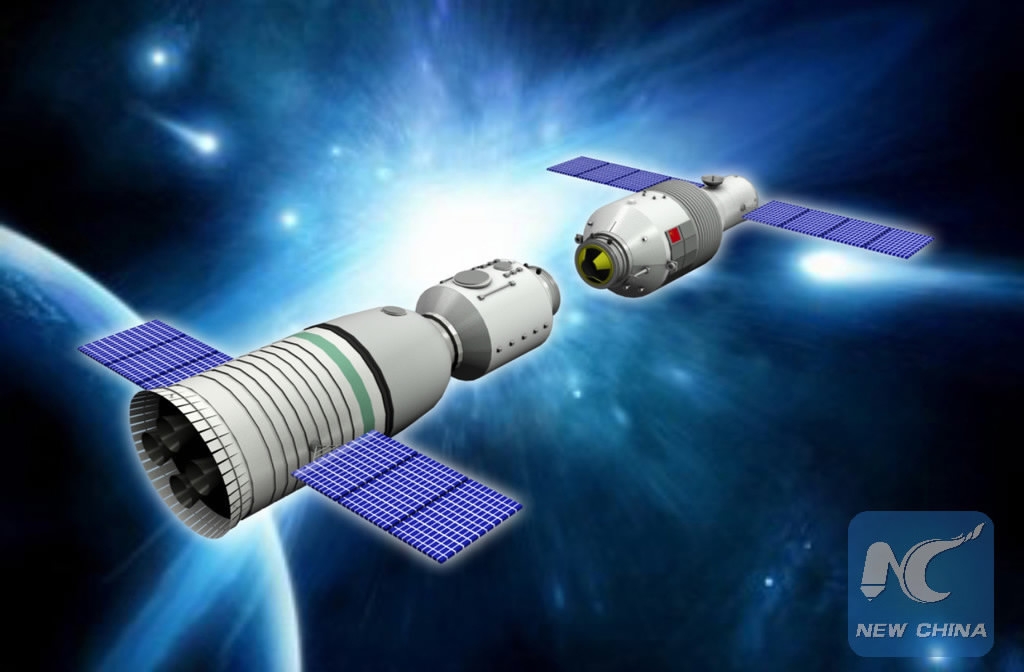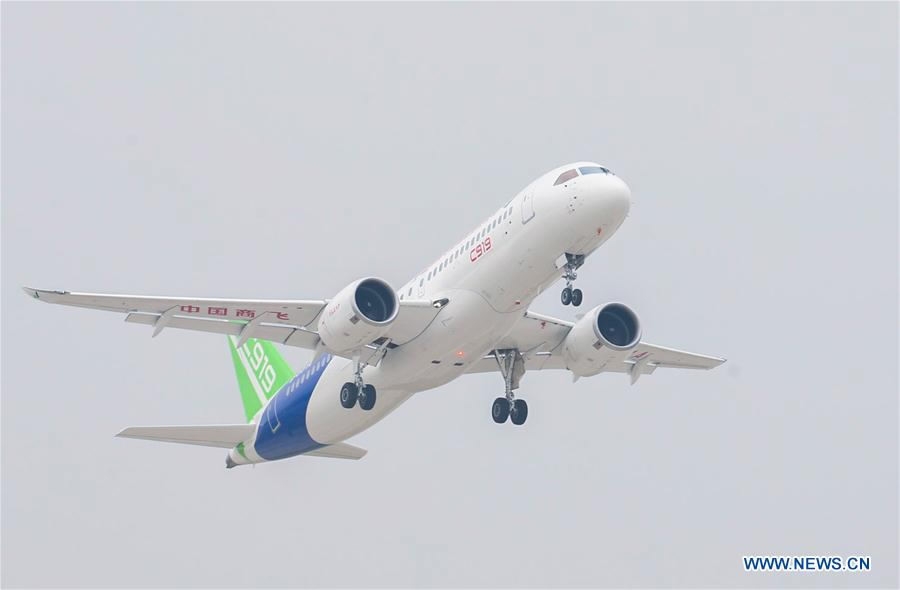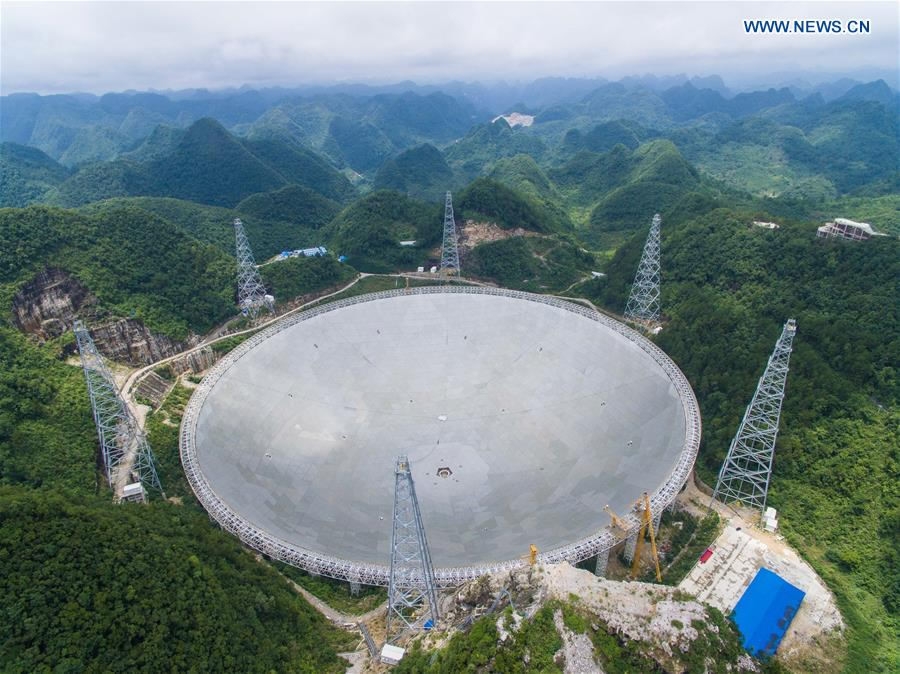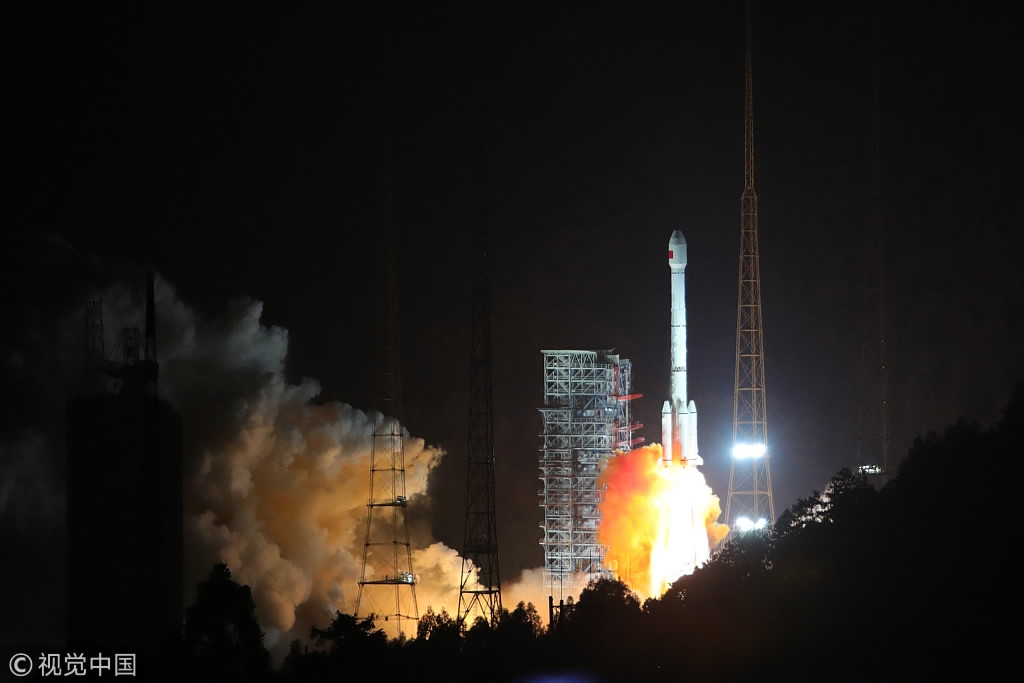A series of breakthroughs have made 2017 a remarkable year in Chinese aerospace. From aircraft to satellites, the innovations have benefited China and the world.
Tianzhou-1: The first ‘space courier’ of China

Tianzhou-1 successfully refueled the Tiangong-2 space lab in orbit on April 27. /Photo via Xinhua
Tianzhou-1 successfully refueled the Tiangong-2 space lab in orbit on April 27. /Photo via Xinhua
China's first cargo spacecraft, the Tianzhou-1, blasted off on April 20 in south China’s Hainan Province. Carried by a Long March-7 Y2 carrier rocket, the Tianzhou-1 successfully refueled the Tiangong-2 space lab in orbit on April 27.
Aside from refueling capabilities, the Tianzhou-1 is also designed to resupply astronauts on a future Chinese space station with food, water and other supplies.
The mission marked the next phase in China’s step-by-step approach towards establishing a permanently manned space station by 2022.
The Tianzhou-1 mission “has far-reaching significance for the space dream that we’ve been chasing,” said the congratulatory message by the Chinese leadership.
C919: China's first homegrown large passenger jet

China’s first home-grown large passenger jet C919 completed its maiden flight on May 5. /Photo via Xinhua
China’s first home-grown large passenger jet C919 completed its maiden flight on May 5. /Photo via Xinhua
The C919, China’s first homegrown large passenger jet, completed its maiden flight on May 5. With a standard range of 4,075 kilometers, the jet is comparable with the updated Airbus 320 and Boeing's new generation 737, signaling the country's entry into the global aviation market.
The "C" in the aircraft's name stands for both China and COMAC (Commercial Aircraft Corp. of China Ltd), while 9 symbolizes "forever" in Chinese culture, and 19 represents the 190-seat capacity.
Six months after the maiden flight, the C919 completed its first long-distance flight on Nov. 10, flying for two hours and 23 minutes from Shanghai to the central Chinese city of Xi'an, a distance of more than 1,300 kilometers.
The second model took off for the first time in Shanghai on Dec. 17. During the flight, engineers examined its performance when taking off and landing and the working status of the various systems and equipment.
Micius: World’s first quantum communications satellite achieves scientific goals

Micius was developed by the National Space Science Center in Beijing under the Chinese Academy of Sciences (CAS). /Photo via Xinhua
Micius was developed by the National Space Science Center in Beijing under the Chinese Academy of Sciences (CAS). /Photo via Xinhua
The first quantum communications satellite of China, which is also the first one in the world, successfully achieved three preset scientific goals in 2017. The results were released on Aug. 10 in the journal Nature.
With a mission named Quantum Experiments at Space Scale (QUESS), the satellite blasted off from the Jiuquan Satellite Launch Center in the Gobi Desert aboard a Long March 2D rocket last August.
The satellite is designed to establish “hack-proof” communications between parties by transmitting "uncrackable" keys from space to ground stations.
FAST: World's largest radio telescope celebrates first anniversary

FAST's key technical parts are the feed cabin, 4,600 triangular panels and the active reflector. /Photo via Xinhua
FAST's key technical parts are the feed cabin, 4,600 triangular panels and the active reflector. /Photo via Xinhua
After spending 22 years in development, the world's largest radio telescope began operations and celebrated its first birthday on Sept. 25.
The immense telescope, located in southwest China’s Guizhou Province, is called FAST, which stands for Five-hundred-meter Aperture Spherical (Radio) Telescope. It enables astronomers to detect weaker and more distant messages from space than ever before.
FAST has identified nine pulsars since trial operations began in September 2016. According to Zhang Shuxin, deputy chief of the NAOC's Guizhou branch, the discovery of more pulsars will be common for FAST in the future.
BeiDou-3 satellites: Navigation system covering the world

China is the third country in the world to own a self-developed sat-nav system, after GPS in the US and GLONASS in Russia. /Photo via VCG
China is the third country in the world to own a self-developed sat-nav system, after GPS in the US and GLONASS in Russia. /Photo via VCG
China's BeiDou Satellite Navigation System (BDS) covers the globe thanks to the two BeiDou-3 satellites launched into space on Nov. 5. The self-developed system has been providing navigation services in the Asia-Pacific region since 2012.
The twin BeiDou-3 satellites – BeiDou-24 and BeiDou-25 – were carried by the Long March-3B rocket, which was fired from the Xichang Satellite Launch Center in southwest China's Sichuan Province.
As the third generation navigation system, the BeiDou-3 provides better services. It is capable with the widely-adapted B1C signals of making the system easier to communicate with other countries' satellites.
Wukong: The Dark Matter Particle Explorer

Wukong has recorded about 3.5 billion cosmic ray events, with a maximum event energy exceeding 100 TeV since its launch in December 2015. /Photo via VCG
Wukong has recorded about 3.5 billion cosmic ray events, with a maximum event energy exceeding 100 TeV since its launch in December 2015. /Photo via VCG
Chinese scientists believe that they have made a breakthrough in dark matter research using data from China's first astronomy satellite – a space telescope called "Wukong," or Dark Matter Particle Explorer (DAMPE).
The findings were released in the scientific journal Nature on Nov. 30. Since Wukong’s launch in December 2015, it has recorded about 3.5 billion cosmic ray events, with a maximum event energy exceeding 100 TeV.
During its first 17 months of exploration, Wukong was able to detect 1.5 million cosmic ray electrons out of a total of 25 billion events, with unprecedentedly low particle background contamination and high energy resolution.
AG600: World’s largest amphibious aircraft

China’s first self-developed amphibious aircraft AG600 completed its maiden flight on Dec. 24. /Photo via VCG
China’s first self-developed amphibious aircraft AG600 completed its maiden flight on Dec. 24. /Photo via VCG
China’s first self-developed amphibious aircraft, the AG600, completed its maiden flight on Dec. 24, marking a milestone in the country's amphibious aircraft development.
Designed to be the world’s largest amphibious aircraft, the AG600 is 37-meters long, which is around the size of Boeing 737. It has a wingspan of 38.8 meters, and will be used for extinguishing wildfires and maritime rescue.
The amphibious aircraft, China's first, is considered to be a work of indigenous innovation because it consists of more than 50,000 components and 98 percent of them were provided by domestic suppliers. Moreover, 95 percent of the onboard products were made in China.
After successfully completing 50 percent of its maiden flight mission, Zhao Peng, the director of the AG600 maiden flight, said the AG600 will be put on its maiden water flight sometime between May and August next year.










